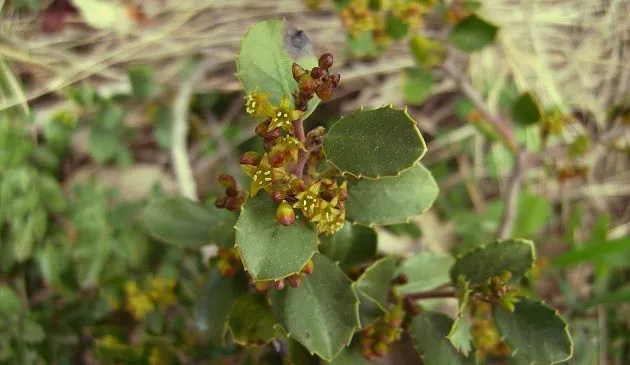Rhamnus alaternus It is widespread in the southern part of Spain (Mediterranean), among other countries. It is a crop in the form of a shrub that grows in dry areas (indicator of dryness), in alkaline soil and is comfortable growing in coastal environments, whipped by saline winds.
Its common name is aladierna, and usually grows above 2 meters, although it is considered a minor tree or shrub. It is very common to see it in Mediterranean forests, dry and hot. Its leaves are small and have little density, leaving free its fruits in the form of berries that, when ripe and acquire red tones, are very attractive to birds.
Of these berries, effects and medicinal properties have been documented that today are still used in traditional medicine.
Table of Contents
Cultivation of Rhamnus alaternus
- Sun exposure: sun and semi-shade.
- Irrigation: withstands drought well. They tolerate marine environments.
- Temperature: very warm areas with high temperatures.
- Soil: it supports all types of soils, although it prefers those limestone and stony.
- Multiplication: by wooden cuttings from July or autumn. By seeds, from autumn.
The most common is multiplication through cuttings, since doing it by seeds is more complicated.
Multiplication of Rhamnus alaternus by means of seeds:
To achieve the germination of the seed, it must be stratified. Subject it to cold refrigerator in the 3 months of winter.
Once the winter period passes, with the arrival of spring, its seeds are sown in pots with substrate and a part of sand. Germination is very slow and can take between 1 and 2 months to complete. Always keep the substrate moist.
From 30 cm, the transplant is done to a pot or the part of the garden where we want to plant it.
Blooms in winter and spring and the fruits ripen once the summer ends and the autumn months begin.
Medicinal uses of Rhamnus alaternus

Parts used: bark, leaves and ripe fruits.
Rhamnus alaternus it has historically been used for its medicinal properties. The Nordic people knew some of them and prepared syrups based on the ripe fruits, due to their purgative effect.
In fact, the laxative effect is today one of the most widely used medicinal properties of Rhamnus alaternus, to combat constipation.
In case of stomach pain, immediately suspend your intake. Remember not to extend your consumption as much as possible, consulting an expert in the field.
Active ingredients
- Ramnoxanthine
- Oxylentinetraquinone
- Raimonigrina
How to use
- Infusions: it is prepared by boiling 30 grams of leaves on 1 liter of water. It can be used to gargle or in topical application to heal wounds or soothe irritations.
- Jam: It is prepared from the fruits and serves as a light laxative.
- Maceration: macerating 2 tablespoons of ripe fruits for each cup of water (200 ml). The mixture rests for 8 hours and then filters, removing any remaining solid. This filtering of Rhamnus alaternus it can be consumed on an empty stomach or at the end of the day to help with constipation problems, as with infusions.
Against a sore throat
To reduce inflammation and sore throat caused by inflammation of angina, boil in 1 liter of water with 30 grams of leaves, for 10 minutes, 30 gm of leaves of Rhamnus alaternus. Gargle every hour with the warm infusion.
This medicinal plant can be combined with other products of recognized effectiveness against sore throat, such as rosemary honey.
Other uses
The wood of Rammus alaternus is recognized in joinery, because it is quite elastic and has a color very similar to chestnut (for the manufacture of tool handles, for example).
It can be used as an ornamental plant to cover fences or gates.
Bibliography
- Bañón, S., Ochoa, J, Fernández, J.A., Franco, J.A., Martínez-Sánchez, J.J., Alarcón, J.J., Sánchez, M.J., Torrecillas, A. (2001d). Hardening of aladierno seedlings due to water and environmental stress. Symposium of the Spanish Association of Terrestrial Ecology. Ecosystem Restoration in Mediterranean Environments. Possibilities and limitations. Alcalá de Henares, Madrid. Cisneriana University 20 and 21 September 2001. Book of abstracts: 15.
- Crosti, R., Ladd, P.G., Dixon, K.W., Piotto, B. (2006). Post fire germination: the effect of smoke on seeds of selected species from the central Mediterranean basin. Forest Ecology and Management, 221: 306-312.
- Martínez Solis, I., Iranzo, J., Estrelles, E., Ibars, A.M. (1993). Leaf domatia in the section Alaternus (Miller) DC. of the genus Rhamnus (Rhamnaceae). Botanical Journal of the Linnean Society, 112: 311-318.
